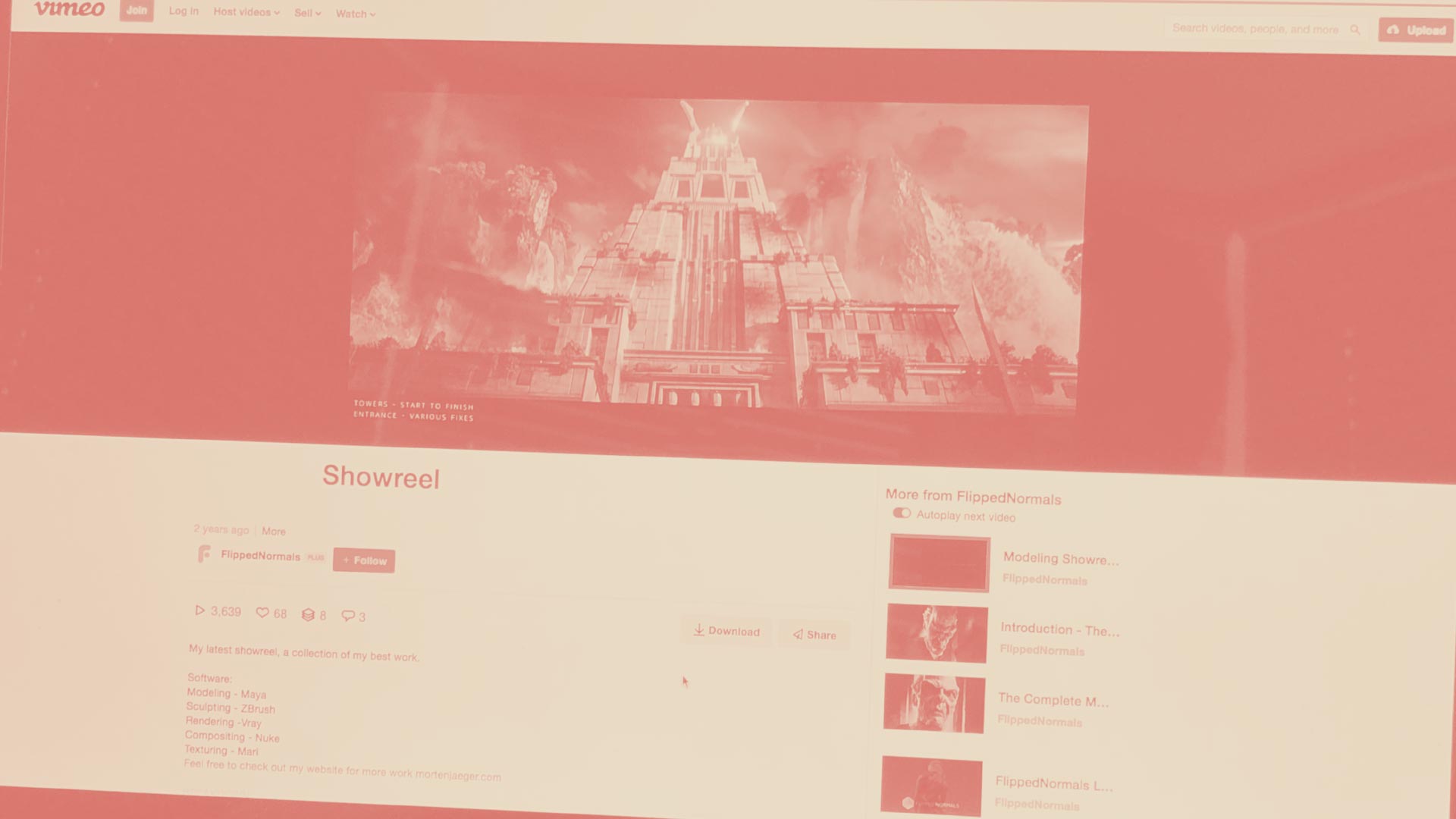Learn How Portfolios Are Reviewed in the Games Industry
Gavin Goulden is an Art Director at Insomniac Games
Let's get started by clarifying what I mean by “Demo Reel”, as there are certainly exceptions to the case. When I say “Demo Reel” I mean the standard video, about 3 to 5 minutes long, showing the rotating character on a turntable, generally phasing through digital sculpt, render, and low poly model. This video is usually a mandatory part of attending and graduating from schools in North America and, presumably, worldwide.
I am specifically looking at demo reels for character artists in games, as that is my industry and trade. There are obvious exceptions to this rule, such as being an animator, VFX artist, rigger, etc. Generally, if your job requires motion, a demo reel is fairly standard and expected. I avoid these exceptions, again, because it is not an area of expertise and the “Yes, but...” type argument distracts from the main point of view I am trying to share. Regardless, this is a greatly shared opinion of Leads, Art Directors, Hiring Managers, and Recruiters related to the games industry and common reasons why demo reels are not as helpful as you may think when searching for a job.
TL;DR
- Time spent creating a demo reel can be better-used modeling and texturing.
- Not an easily shared format for your work.
- Time-consuming for the viewer, especially during recruitment.
- Unreliable video formats and complications from browsers.
- Most working artists use Artstation and everyone knows how to use it.
Why Do I Hate Demo Reels So Much?
Over the years, seeing specific trends in student portfolios has lead me to have a more outspoken stance on what should and shouldn't be in portfolios. The main one, as you may guess by the title of this article, is the inclusion of demo reels. More often than not, the feedback from students is that this is a mandatory part of their curriculum, and even some teachers are pressured to keep this as part of the curriculum due to politics, funding issues, and the level of bureaucracy that comes along with the job.
So, year after year, despite my peers saying the opposite, students graduate from school with a demo reel only to find that most reviewers skip through it. It lands on people like me, senior members of the industry in a hiring position, to tell them the truth and practically tell them to retool their portfolio and undo the past few months of work they were required to do.
This is incredibly frustrating to me and the frustration is directed to teachers and schools, not the students. It's frustrating because, what this tells me, is that schools are taking huge tuition and promising to teach students the latest and greatest techniques, only to leave them a step behind the industry. It is forcing precious time to be wasted on dated techniques, abusing the trust students put into the school, and leaving workers in the industry in the position of being “The Bad Guy.” While being the person to give critique, and to help improve a person's work, is one thing – being the giant, open-handed slap, of reality is too common and not something most people enjoy doing. However, most time, this reality check is through multiple, quiet rejections instead of an in-person conversation. This is one of my attempts to spread a commonly held belief and to shed some light on why your portfolio may be getting rejected and offer alternatives to schools to produce students that have a stronger portfolio.
While these may seem like harsh truths, I assure you they come from a place of experience and a desire to improve the landscape of candidates and the quality of work students produce coming out of school.
The Student's Time is Wasted
Many leaders, not just in the games industry but from all over, will tell you that the greatest resource is time. In this case, it is the time students spend creating a demo reel. While it may seem trivial, the task generally isn't. Most students have this as a mandatory class where a reel must be produced in order to achieve a passing grade. The class may be minor, it may be a few hours a semester, but at that level, a student can be learning other techniques to improve their art.
Breaking down what is generally required for a student to create a demo reel, and comparing it to the usual tools they are equipped with, a student will sink a lot of time into learning software and special case applications. Consider this scenario: You are just learning to use Maya and Photoshop, most likely got a crash course in the different uses of those programs (modeling, Uvs, rigging, animation, etc.), and are still trying to figure out what you want to do for your career – now that the basics have been covered and you need to being producing your own work for your end project, the Demo Reel.
It seems like you should probably be locked in a room and improve those skills for a year, but the reality is that many courses will then pile on courses that serve as an interruption. For example, you want to focus on making character art, but now need to learn rendering in a 3d program (usually Maya or Max, which is irrelevant to real-time results), have video editing courses like Premiere/After Effects, and then the time spent rendering out frames of your character in multiple scenarios, usually different angles and rendering modes, and compiling that all together. It adds up. In that time, a student can polish a model further, learn a relevant piece of software, or even produce an entirely new character with the improvements to the skill set they have learned over time.
This usually results in a trade-off of skills versus passing a course to get a grade. The result is usually that a student learns a viable skill in their free time, has a very basic understanding of common tools used in the industry, or even worse – has no idea that they exist. For example, the time spent preparing this demo reel, which is usually seen as the most important thing you can do, could be spent learning Substance Painter and PBR materials for real-time engines. Many portfolios I see lack that skill, which is an extremely important part of creating art for games in this current generation.
This leads me to my next point that is often overlooked: Most art, whether it be from a student or on a full-fledged game project, is better at the end than it is in the beginning. This is natural, as we are all learning as we work. We get more comfortable with tools, we learn better techniques, art direction becomes more solidified, and the period of trial and error comes to an end. Not realizing this puts students in a bad situation. More often than not, a student's first character is in that portfolio or demo reel because if they didn't include it, their body of work would be very thin.
This means you are literally showing the first thing you ever made right next to the last thing you are proud of, and they're of equal importance to the viewer. Then, the students that realize this and want to correct what they are showing potential employers, end up creating a handful of sculpts to showcase their new skills – but this actually hurts their portfolio because it means showing unfinished work and, generally speaking, a bunch of sketches. With that time spent on rendering and editing together videos, a student could replace an older piece with a new piece that better demonstrates their skills.
Based on my research, a demo reel is generally the centerpiece of a student's time in the school, what wraps all of the lessons together, and, in some cases, what is needed in order to secure funding and prove a standardized education. That may be the case, and if it is, turning the battleship of larger schools is going to be an uphill battle. My suggestion is to make this demo reel, and I'm specifically talking to instructors, the bare minimum in your class with the transparency that it is a class project only and not mandatory for the job application process. Provide a lit scene in Marmoset for your class, render turntables out and compile them into a video. If the requirement is bureaucratic in nature, treat it as such. Spend as little time on this as possible in your class, “check the box”, and focus on skills that will get your students placed in the industry.
Demo Reels Are Difficult to Share
Put yourself in the shoes of someone in a hiring position, then consider that we live in a time of Twitter, Instagram, and Facebook. On top of that, consider yourself – the artist – as a brand. That may seem incredibly arrogant, but it's the truth. As an artist, especially an artist trying to get into the games industry, you want to self-promote and get your work in front of potential hiring managers as much as possible. The odds of this happening is much greater as still images through a link to your portfolio versus a video format for a few reasons.
First, someone in a hiring position is usually quite busy, and if someone passes them a video link they will either not look at it at all or check an email while your model is spinning around on the other screen. A video is a lot easier to ignore than a direct link to your artwork. In a single click, I can see all of your work and contact info, or be lead to a page where I need to click a video, wait for it to load, then stare at the video for 5 minutes as models spin around to music I, most likely, don't enjoy. Which of these scenarios seems less irritating and more likely to get shut down?
Second, the recruitment process is usually quite involved. You are almost always put into a pile with other artists. Each review of an artist takes time, even a few minutes adds up when multiplied by the number of candidates applying for the job. If you are asking a hiring manager to sit through a 5-minute video to review your work, frankly, you do not value their time as much as you should. You are running a huge risk of not having the reel viewed at all and your application rejected, why sit through a 5-minute video for one applicant when I can review 5 other portfolios in that time? In the end, for someone in a hiring position, it is usually on top of the daily work they need to do.
This isn't a scenario where portfolios are sifted through with a fine-toothed comb and cherished, and given feedback like from a teacher or during a portfolio review session at GDC. Instead, it is a very aggressive and objective process where decisions are made on first impressions and the immediate impact of your artwork. Quick decisions are made because they need to be if every candidate was given the time to have their demo reel viewed in its entirety, the rest of the work would suffer.
Third, Demo Reels take the viewer away from the artist's portfolio. Usually, there is a video link to YouTube or Vimeo that directs attention away from the portfolio itself and contact information of the artist. Sure, the video may just be on a different tab, but you are creating an inconvenience for the viewer and a potential risk of just having the video lost in a shuffle of Chrome tabs.
Put still images of your work in a portfolio, either your own website or an ArtStation profile, this directs the viewer to all of the vital information they need in one shot. Your artwork is front and center, and the contact info is literally on every page. It's virtually impossible to get lost on a well-made site, and even more so on ArtStation, and can be easily passed around the office as a single link.
Video Is Unreliable
When showing your work to a potential employer, you want to control the experience and put your best foot forward. You want all of your best work and skills to be shown and to prove you are a good fit for the project. Demo reels take all of that control away from you. Let me share a few scenarios to illustrate my point:
A demo reel is sent to a potential employer. The person opens your demo reel and is faced with around 10 seconds of title cards, then a series of spinning characters showing multiple angles of an asset and different viewing modes, then a texture breakdown. Most likely, the person viewing this video is going to skip around and right over elements of the character you wanted to show. Your expectation is that they will view the video from beginning to end, but the more likely case is that they will skip ahead to see what pieces of work you have and then back to see specific cases. That is if you are lucky and managed to win the gamble of a viewer landing on the few frames that show your work in the best possible way.
Let's pretend that the person viewing your video isn't as over it as I am. It could be their first time hiring someone, or you caught them on a slow morning and they're feeling generous. By the very nature of the demo reel, it is showing many different angles of the same character multiple times. If the viewer wants to stop the video or scrub back and forth to see a specific angle, you are risking your work being distorted due to video compression, motion blur, fx, etc., and the possible frustration of clicking back and forth to find a specific shot.
Then, let's pretend that you find a person who has no choice but to watch your demo reel. You have found them at a portfolio review, at your school or at a convention, and you walk up to them with your demo reel. There are a few obstacles you are creating for yourself that you may not realize. First, if your video isn't saved locally, you are going to have a hard time loading the video. You are most likely running on WiFi and will have a horrible signal due to the amount of interference in the building.
I have seen this first hand and 100% of the time, the video fails to load and the time someone spent waiting to get reviewed is completely wasted. Second, like the points above, you are going to spend a lot of your time watching a viewer watch your video. Considering that most portfolio reviews have a time limit, you are robbing yourself of meaningful critique by having a video dictate the timing of your review. Third, a video has limited options when viewing. If the viewer wanted to zoom in on your iPad and look at a model, it isn't as simple as just zooming in on a photo. You are going to watch a person fumble with your device just to get a better look at your work. Fourth, there is absolutely no way a stranger is going to let you load a file onto their computer or device. They will, however, potentially view your ArtStation profile and look at some images.
Demo Reels Are Below The Industry Standard
My final, and possibly most important argument against demo reels, is that they are below the commonly accepted standard of the games industry. Most, if not all, employed game artists use their own website or ArtStation to host and promote their work. That work is almost always shown in still images with a favourable lighting setup and neutral pose, with material and wireframe breakdowns for the character. Beyond that, technology like Marmoset Viewer and Sketchfab exist and are embedded into a site like ArtStation. If you really want to show off your model, you can have it in a viewer where people can spin around and zoom in at their leisure – you get to control the experience in an optional, interactive way, in addition to still images.
All. On. The. Same. Page.
For the reasons I mention above, it has become more commonplace. Artists are creating work personally and professionally, then using still images to show off and share their skills with the world. A format like ArtStation is a part of the 'community', artwork is discovered through trending pieces and sharing quick links on social media. At the risk of sounding condescending, to have a demo reel is to show that you are not part of that community. That you haven't learned those lessons and are still entirely new to the game. You're not one of the cool kids.
Sketchfab is a great tool for previewing your 3d models - and it's supported on ArtStation. Emilie Stabell.
Demo reels are an archaic form of showing your work stemming from the days of acting and film. A time when you would literally mail a VHS to a company in an attempt to get an interview. We have outgrown that need as a culture, we exist in a time where employers have their pick of artists, competition is fierce, and technology moves quickly. We have tools to automate parts of our workflow, we are in constant contact through social media, and are more accessible than ever before. People don't spend time watching rotating models to dubstep anymore, they seek instant gratification and have the attention span of a goldfish. The times have changed, the landscape of the industry has changed, and you need to keep up with it or be left behind.
But, here is the silver lining, it isn't your fault. For years, you have been working towards this demo reel because it is the final piece to your education and what you have been told to do by your school. You are doing the best that you can with the tools you have been given and just learned how to use.
A counterargument to this point, usually, is that not all of the blame goes to the school. Students should be proactive and expand their learning outside of class. That they should research the industry in addition to their course load, and put in the work. This may be true, and I'll admit that even as an industry veteran, most of my learning is done outside of work, but the difference is a matter of trust and authority. As an instructor, you are put in a place of power and are given the trust of students to be steered in the right direction. If that direction is putting them behind where the industry currently sits, you are reducing their chances of getting hired. By continuing to produce something that many people in a hiring position ignore, you are setting up students for failure. Sure, there may be edge cases where it worked out, but for the majority of the time, it creates a sea of work that stands out from what is standard in the industry and not in a good way. There is a clear divide between student and professional and that is usually by having a demo reel or having a portfolio.
Conclusion
If I am an aspiring character artist, should I make a demo reel? No. A thousand times, No. Your time is better spent mastering the core skills of your craft and pushing your work as much as you possibly can. No one will hire you based on your ability to edit a demo reel as a character artist, but they will hire you for that new model you just finished.
I am an instructor and my students are required to complete a demo reel, what should I do? Please, if it is possible, understand the context of your student's discipline. If they need motion in their work, make a demo reel mandatory. If they do not, make an Artstation profile mandatory and teach them how to better edit their work and present themselves in a professional way. If it is absolutely required by the school and your hands are tied, tow the line and have it be a minimum effort project with an emphasis on creating a standard portfolio and the common expectations of the industry.






